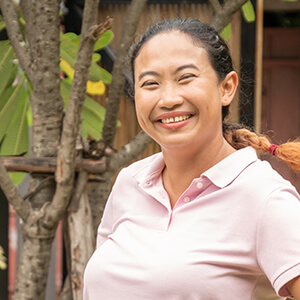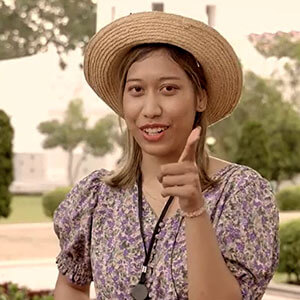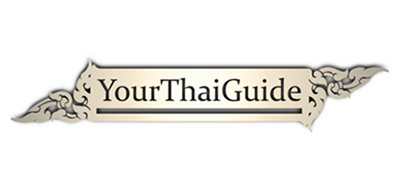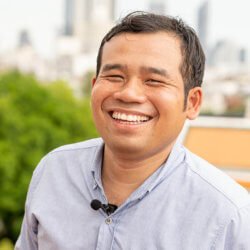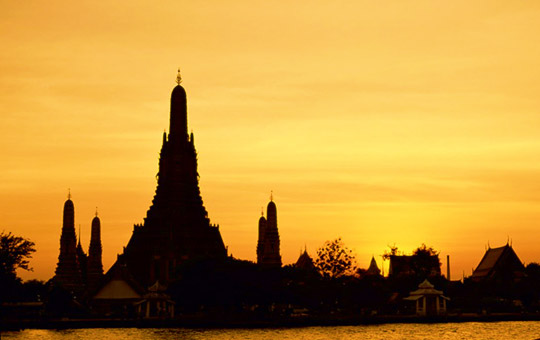
Wat Arun Ratchawararam, meaning Temple of Dawn, is also know locally as Wat Chaeng. The temple, which is named after the Indian God Aruna (God of Dawn) sits majestically on the Thonburi side (west bank) of the Chao Phraya River and is easily one of the most recognizable and memorable landmarks of Bangkok’s skyline. The most spectacular view of the glittering monument can be seen from the east side of the river at sunset as Wat Arun’s colorfully decorated spires sparkle radiantly over the water.
Wat Arun was envisioned by King Taksin in 1768. It is believed that after fighting his way out of Ayutthaya, which was taken over by a Burmese army at the time, he arrived at this temple just as dawn was breaking.

Wat Arun stands as arguably the most stunning temple in Bangkok because of its riverside location and its dazzling design. The grand pagoda (or prang in Thai) at Wat Arun, which is surrounded by four smaller pagodas, has the design features and structure of a Khmer-style pagoda. The 70-meter tall grand pagoda is beautifully decorated with tiny pieces of colored glass and Chinese porcelain placed delicately into intricate patterns. The Emerald Buddha used to be housed in one of the two small buildings located right in front of the Grand Pagoda before it was relocated to Wat Phra Kaew at the Grand Palace. Sculptures of Chinese soldiers and animals decorate the base of the grand pagoda.
Visitors are welcome to climb up to the middle level of the grand pagoda and those that do are rewarded with a beautiful view of the winding Chao Phraya River below as well as the Grand Palace and Wat Pho on the opposite bank of the river.
Wat Arun is involved in the Royal Barge Procession as the temple is where the king would travel by river to deliver new robes to the monks at the end of the Buddhist Lent period.
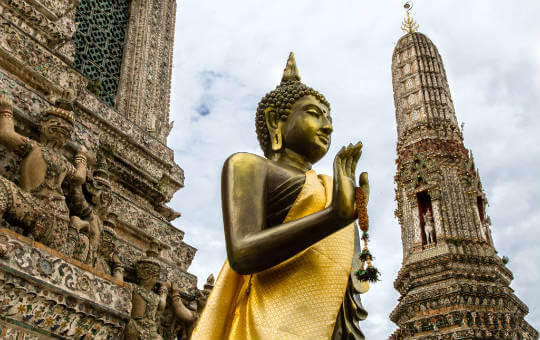
Inside the ordination hall of Wat Arun, where the walls are decorated with many intricate murals, you can view the golden Niramitr Buddha image.
Wat Arun is an architectural representation of Mount Meru, the center of the world in Buddhist cosmology. The position of the outlying pagodas, with their guardian images facing in four directions, and the grand pagoda in their middle reinforces the temple’s symbolism.
Other things to see at Wat Arun:
- Over the second terrace are four statues of the Hindu god Indra atop the three-headed elephant Erawan.
- At the riverside are six Chinese style pavilions that contain landing bridges where the Royal Barge Procession arrives.
- Next to the pagodas is the Ordination Hall with the Niramitr Buddha image, said to have been designed by King Rama II. King Rama II crafted the face of the Buddha image out of wood and then covered the design in gold leaf.
- Wat Arun has the most beautiful Boundary stone and tower in Thailand. This stone can be seen around Wat Arun’s Ordination Hall. The boundary stone was crafted entirely out of marble.
- Mural paintings inside the Ordination Hall tell the story of Buddha’s life before he became Lord Buddha.
Wat Arun can be visited every day of the week from 8am until 5:30pm.
Admission Price: Entry to the temple is 50 Baht.
Things you should be aware of when visiting Wat Arun:
- Respectful attire is required. Wat Arun is a functioning Thai Buddhist temple, and as such the management insists that visitors dress in a respectful manner. This means that men must wear long pants and short-sleeved or long-sleeved shirts (no tank tops or sleeveless shirts). Women must wear skirts or pants extending at least to the knee, and also should not wear a top that reveals bare shoulders.
- Visitors are allowed to take photographs in any area of the complex.
- The steps leading up the main pagoda at Wat Arun are quite steep and caution should be taken when ascending and descending.
- At the very top of the main pagoda is a king’s crown, placed there by King Rama III.
- Wat Arun is the private temple of King Rama II, as some of his ashes are kept under the main Buddha image in the Ordination Hall.
